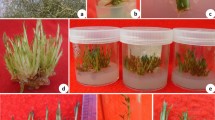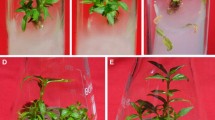Abstract
Shoot-tip explants of evergreen azalea cv. Fuchsia grown on Anderson's medium and containing different cytokinins produced the highest proliferation rate on a medium containing thidiazuron (TDZ). TDZ concentrations ranging from 0.23 to 2.3 μM resulted in both good bud-break rate (4 to 5) and shoot quality (> 0.5 cm in length). Adding 2.3 μM zeatin to Anderson's medium containing 0.23 or 2.3 μM TDZ increased the number of axillary shoots/explant. However, increasing the zeatin concentration to 4.6 μM resulted in a reduced shoot proliferation rate. A medium containing 1.15 μM TDZ and 2.3 μM zeatin resulted in an 18-fold increase for 'Fuchsia' and a 9-fold increase for 'Hino Crimson' after 6 weeks of culture. It was found that explants grown on a half-strength Anderson's medium with 87.6 mM sucrose generally had better shoot proliferation rate and shoot quality than at higher ionic strength.
Similar content being viewed by others
References
Anderson, W.C., 1975. Propagation of rhododendrons by tissue culture: part 1. Development of a culture medium for multiplication of shoots. Proc Intl Plant Prop Soc 25: 129-135.
Anderson, W.C., 1978. Rooting of tissue cultured rhododendrons. Proc Intl Plant Prop Soc 28: 135-139.
Anderson, W.C., 1984. A revised tissue culture medium for shoot multiplication of rhododendron. J Amer Soc Hort Sci 109: 343-347.
Briggs, B.A., 1988. Micropropagation of azalea using thidiazuron. Acta Hort 227: 330-333.
Choudhary, M.L., 1991. Effect of medium components and explant position on in vitro shoot proliferation of Indian rose. Nat Acad Sci Lett 14: 439-441.
Economou, A.S. & E. Read, 1981. Effect of benzyladenine, kinetin, and 2-isopentenyladenine on in vitro shoot formation of hardy deciduous azaleas. Proc Plant Growth Reg Soc Amer 8: 8-14.
Economou, A.S. & E. Read, 1986. Microcutting production from sequential reculturing of hardy deciduous azalea shoot tips. HortScience 21: 137-139.
Ettinger, T.L. & J.E. Preece, 1985. Aseptic micropropagation of Rhododendron P.J.M. hybrids. J Hort Sci 60: 269-274.
Fordham, I. & D.P. Stimart, 1982. Axillary and adventitious shoot proliferation of exbury azaleas in vitro. HortScience 17: 738-739.
Kyte, L. & B. Briggs, 1979. A simplified entry into tissue culture production of Rhododendrons. Proc Intl Plant Prop Soc 29: 90-95.
Huetteman, C.A. & J.E. Preece, 1993. Thidiazuron: a potent cytokinin for woody plant tissue culture. Plant Cell Tiss Org Cult 33: 105-119.
Hyndman, S.E., P.M. Hasegawa & R.A. Bressan, 1982. The role of sucrose and nitrogen in adventitious root formation on cultured rose shoots. Plant Cell Tiss Org Cult 1: 229-238.
Iapichino, G., T.H.H. Chen & L.H. Fuchigami, 1991. Adventious shoot production from a vireya hybrid of rhododendron. Hort Science 26: 594-596.
Marroquin, C. & T. Kodama, 1989. Progress in reducing the cost of micropropagation. IAPTC Newslett 59: 2-12.
McCown, B.H. & G.B. Lloyd, 1983. A survey of the response of rhododendron in vitro culture. Plant Cell Tiss Org Cult 2: 77-85.
Mok, M.C., D.W.S. Moc, D.J. Armstrong, K. Shudo, Y. Isogai & T. Okamoto, 1982. Cytokinin activity of N-phenyl-N′-1,2,3-thidiazol-5-ylurea (thidiazruon). Phytochemistry 21: 1509-1511.
Mok, M.C. & W.S. Mok, 1985. The metabolism of [14C]-thidiazuron in callus tissues of Phaseolus lunatus. Physiol Plant 65: 427-432.
Mok, M.C., D.W.S. Moc, J.E. Turner & C.V. Mujer, 1987. Biological and biochemical effects of cytokinin-active phenylurea derivatives in tissue culture systems. HortScience 22: 1194-1197.
Murashige, T. & F. Skoog, 1962. A revised medium for rapid growth and bioassays with tobacco tissue cultures. Physiol Plant 15: 473-497.
Norton, M.E. & C.R. Norton, 1985. In vitro propagation of Ericaceae: A comparison of the activity of the cytokinins N6-benzyladenine and N6-isopentenyladenine in shoot proliferation. Scientia Hort 27: 335-340.
Strode, R.E., P.A. Travers & R.P. Oglesby, 1979. Commercial micropropagation of Rhododendrons. Proc Intl Plant Prop Soc 29: 439-442.
Thomas, J.C. & F.R. Katterman, 1986. Cytokinin activity induced by thidiazuron. Plant Physiol 81: 681-683.
Vijaya, N. & G. Satyanarayana, 1991. Effect of culture media and growth regulators on in vitro propagation. In: J. Prakash & R.L.M. Pierik (Eds) Horticulture — New technologies and applications, pp. 209-214. Kluwer Academic Publishers, Netherlands.
Wong, S., 1981. Direct rooting of tissue cultured Rhododendrons into an artificial soil mix. Proc Intl Plant Prop Soc 31: 36-39.
Author information
Authors and Affiliations
Rights and permissions
About this article
Cite this article
Hsia, CN., Korban, S.S. The influence of cytokinins and ionic strength of Anderson's medium on shoot establishment and proliferation of evergreen azalea. Euphytica 93, 11–17 (1997). https://doi.org/10.1023/A:1002945922280
Issue Date:
DOI: https://doi.org/10.1023/A:1002945922280




